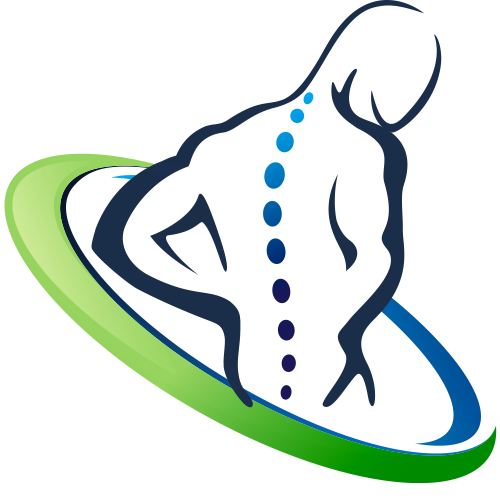I have been a practicing chiropractor for twent-three years. I work in perhaps the most chiropractically concentrated region of the country. Along with New York, the Los Angeles regions of Beverly Hills and West Hollywood have more chiropractors per square mile than any other parts of the world. San Francisco, Boston and Chicago also have high concentrations of chiropractors, so people living in any of these cities have real challenges when it comes to finding the right chiropractor for them.
That’s what this article is about: finding the right chiropractor to suit your needs—what things you’ll need to consider, what questions you’ll want to ask, and how to know if you are really talking to a quality office when you call…well, if that’s anything at all that you care about.
I do want to point out that the challenge of finding a chiropractor is not solely reserved for city life, it can be equally, if not more, challenging to find the right chiropractor in rural areas. So in essence, this article is for everyone.
Things You’ll Want to Consider When Looking for a Chiropractor
 First things first, not all chiropractors are the same. I did not know this going into chiropractic school, and I’ve been a chiropractic client my entire life. But so it is, not all chiropractors are alike. So how do you know which one is for you? Why does it matter?
First things first, not all chiropractors are the same. I did not know this going into chiropractic school, and I’ve been a chiropractic client my entire life. But so it is, not all chiropractors are alike. So how do you know which one is for you? Why does it matter?
To answer these questions, let’s first look at the most fundamental difference among chiropractors. The primary debate within the chiropractic community is whether chiropractors should only adjust the spine. Is adjusting more than the spine desirable or even necessary? And most important, is it chiropractic at all? Let me clarify: Chiropractors that adjust the spine only are called straight chiropractors. Straights focus on spinal subluxations; they adjust the spine to maximize the inherent healing and wellness power of the body—called Innate Intelligence. These chiropractors do not treat pain, use no physical therapy modalities, and do not adjust extra-spinal regions like the wrists or feet.
 Mixers, on the other hand, do more than just adjust the spine. They might do therapy, diagnose musculoskeletal pain conditions, adjust elbows, ankles and other non-spinal areas, and focus primarily on pain relief. They may use several different techniques in treating clients, the “whatever works” protocol. Being a mixer does not necessarily mean that Innate Intelligence is rejected, but the truth is that some mixers do scoff at the notion. In chiropractic circles, these types of mixers are called medipractors. It is argued that these chiropractors are nothing more than glorified physical therapists.
Mixers, on the other hand, do more than just adjust the spine. They might do therapy, diagnose musculoskeletal pain conditions, adjust elbows, ankles and other non-spinal areas, and focus primarily on pain relief. They may use several different techniques in treating clients, the “whatever works” protocol. Being a mixer does not necessarily mean that Innate Intelligence is rejected, but the truth is that some mixers do scoff at the notion. In chiropractic circles, these types of mixers are called medipractors. It is argued that these chiropractors are nothing more than glorified physical therapists.
In my Los Angeles, Beverly Hills and West Hollywood chiropractic office, my clients know that I adjust the spine to enhance the power inherent in the human body. I teach my clients about Innate Intelligence and how a spine without subluxations leads to an optimal functioning nervous system, and this leads to vibrant health. But I also focus on pain relief. A contradiction? No. People have pain; people have injuries; people have biomechanical dysfunctions that lead to chronic subluxations. Yes, I encourage all my clients to make chiropractic care a part of their lifestyle, in the same way exercise and good diet are; but I’ve got to start somewhere, and getting people out of pain is where I begin. In my office, people get the best of both worlds.
So the first thing you’ll want to consider when looking for a chiropractor is whether you’re in need of pain relief, or if you are simply looking for a chiropractic office to add to your wellness team.
Chiropractic Techniques
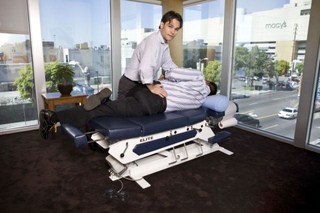 The next thing you’ll want to consider is what chiropractic techniques the doctor uses. Now, again, I understand if you have no idea what this means or why it matters. I knew nothing of chiropractic techniques before entering Chiropractic College. But just so you know, there are scores of chiropractic techniques. The chiropractor you are considering may practice one exclusively (a master of one), or have many tricks up his or her sleeve (a utilizer of many). Either way, it is a good idea to know which technique(s) you will be experiencing. Here’s why:
The next thing you’ll want to consider is what chiropractic techniques the doctor uses. Now, again, I understand if you have no idea what this means or why it matters. I knew nothing of chiropractic techniques before entering Chiropractic College. But just so you know, there are scores of chiropractic techniques. The chiropractor you are considering may practice one exclusively (a master of one), or have many tricks up his or her sleeve (a utilizer of many). Either way, it is a good idea to know which technique(s) you will be experiencing. Here’s why:
Although all chiropractic techniques are focused on correcting subluxations, how the adjustment is administered can differ considerably. Some chiropractic techniques are called force techniques—that is, they require a little umph to open the joint or correct the subluxation. Other techniques are non-force—as their name implies, they are generally light-touch techniques.
This information is important because people have varying sensitivity levels. Some people cannot take too much force—it is too large an input into their nervous system. Others, however, do not respond to light touch. These are facts—I’ve seen it in my practice, and I have experienced it personally. I’ve had patients in my Los Angeles, Beverly Hills, and West Hollywood chiropractic office that despite the gentleness and perfection of the adjustment, they’ve felt a little off-kilter afterward. When I switched to a non-force technique like Network Spinal Analysis (NSA), craniosacral therapy, or SOT (sacro-occipital technique), they then flourished.
The opposite is also true. For instance, I personally respond poorly to non-force techniques. Being a student of the many, I have studied several non-force techniques thoroughly. I have been under the care of Network doctors who were phenomenal at their craft. Didn’t matter—I got very little from the work myself. It doesn’t mean those techniques don’t work—as I’ve said, they do. I seen people have miraculous healing experiences with all the non-force techniques I’ve just mentioned. As one of my colleagues explains it, “Non-force techniques are like your nurturing mother—soft and comforting, gently guiding you to health; whereas force techniques are like your nurturing father—firm and to the point, quickly and effectively getting you to where you need to go.” Exactly right—my colleague’s description is spot-on. Some people resonate more with soft, gentle nurturing, while other do better going right to the point.
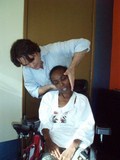 The primary techniques I use are traditional manual osseous adjusting techniques, or force techniques. I practice Gonstead and Diversified which are your typical “move ‘em quickly and effectively and leave ‘em alone” chiropractic techniques. They are very effective at getting quick and lasting results. No long drawn-out treatment plans. Short and sweet and back on your feet, quickly. Because I am a mixer, I also throw in therapies like electric stimulation, heat and ultrasound depending on the problem. But in my Los Angeles, Beverly Hills, and West Hollywood chiropractic practice, we get people out of pain and back into their lives faster than if simply put under the care of a softer technique.
The primary techniques I use are traditional manual osseous adjusting techniques, or force techniques. I practice Gonstead and Diversified which are your typical “move ‘em quickly and effectively and leave ‘em alone” chiropractic techniques. They are very effective at getting quick and lasting results. No long drawn-out treatment plans. Short and sweet and back on your feet, quickly. Because I am a mixer, I also throw in therapies like electric stimulation, heat and ultrasound depending on the problem. But in my Los Angeles, Beverly Hills, and West Hollywood chiropractic practice, we get people out of pain and back into their lives faster than if simply put under the care of a softer technique.
Saying that, I do practice softer techniques if necessary; I am a mixer, so I have many adjustment forms in my arsenal, including non-force ones. I practice Activator, cranial-sacral, SOT, Thompson, NET, and Network if called for. When I evaluate a patient I find out if they’ve been under chiropractic care in the past, what kind, and how they responded. I also ask if they have any fears or apprehensions. All this information helps me determine the techniques that will be best for the client. That is customized chiropractic care as I practice it.
Chiropractic Colleges
For some, knowing which chiropractic school their prospective doctor went to is important. I really never understood why, myself, until I found out that different schools emphasize different aspects of the chiropractic profession. My school, Cleveland Chiropractic College, Los Angeles was very philosophically oriented. What that means is that we learned about the philosophy which is the basis of the healing art. As we chiropractors say, chiropractic is a philosophy, science and art. Learning every aspect is important, so as it turns out, the school might just matter. Some chiropractic colleges are mostly academically focused with some technique thrown in—they address the science and art of it. Well, I guess two out of three ain’t bad. But I find that without the “why” behind the practice, it becomes something else…perhaps glorified therapy is the right description after all.
Location, Location, Location
As they say, location is everything. Here is my advice when looking for a chiropractic doctor: Pick an office near your home or work. Anything too far out of the way and you’re likely not to go. Now, of course, there are exceptions. I have people that travel to see me. They feel that the care they receive is worth the drive. I also happen to see many long-distance travelers—they come to my office when they are in Los Angeles, Beverly Hills or West Hollywood. I have clients from New York, Paris, Mexico and Brazil. Great—when they are in town they love getting adjusted by me. I definitely encourage world travelers to have chiropractors in every city they visit. But for the most part, make it convenient—you’ll be more likely to go that way.
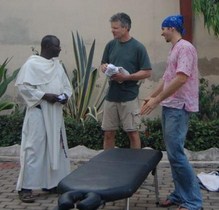 Finally, does the chiropractor travel? Does he or she do house calls? Hotel calls? Studio calls? Theater calls? Whatever. Knowing the mobility availability of a chiropractor is essential for certain professionals like athletes, dancers, actors, movie executives, producers, and people who are just in too much pain to leave their home or hotel. Call the chiropractic office you are considering and ask if the doctor will come to you. Just be prepared to pay a little extra for the convenience; but believe me, for some, it’s worth the price.
Finally, does the chiropractor travel? Does he or she do house calls? Hotel calls? Studio calls? Theater calls? Whatever. Knowing the mobility availability of a chiropractor is essential for certain professionals like athletes, dancers, actors, movie executives, producers, and people who are just in too much pain to leave their home or hotel. Call the chiropractic office you are considering and ask if the doctor will come to you. Just be prepared to pay a little extra for the convenience; but believe me, for some, it’s worth the price.
The First Visit and Other Essentials
The next thing you’ll want to know is what the first visit will be like. Is there an exam, will there be x-rays, how long will it take, and how much will it cost? In my office, all new patients are examined—no exceptions. I’m always amazed at how many people want me to bypass this vital step. “I’ve been under chiropractic care for years, I know what I need.” Great, but I don’t. And I don’t take the patient’s word for it, nor would I take another doctor’s word for it without checking for myself. The reason is simple: The patient could be wrong, the problem could be different even though it might feel the same, the doctor could be wrong, and so on. I’ve had too many experiences with people wanting “a quick adjustment” only to find they have a life-threatening situation that required emergency care. The latest was the seventy-year-old man with constant upper back pain that became excruciating at 9pm only….oh yeah, and sometimes when he walked uphill…oh yeah, and that caused shortness of breath….oh yeah, and that couldn’t be localized (it was a diffuse pain). You get the point. I sent him to Cedars Sinai immediately, against his protests that chiropractic adjustments usually relieve the pain. That was on a Thursday. By Saturday I called him: he was at Cedars Sinai Hospital down the street from my office recovering from bypass surgery following a heart attack (which he had in the ER). He thanked me for saving his life. I didn’t save his life; I just followed protocol and gave him an exam. That’s what I do with all my new patients.

If you are looking for a “quick adjustment,” with no exam, sorry, my office is not the one for you. Just let me say that I caution you from considering any office willing to do that.
Will You Be Treated?
Some chiropractic offices will not treat you on the first visit. I find this practice more likely to happen in a straight chiropractic office. If the office is more geared toward unleashing your Innate Intelligence for wellness purposes, then don’t be surprised if this is the protocol. If you are in pain and need to be treated right away, you’d better ask the office protocol on that. Nothing worse than being surprised on your first visit after filling out all the paperwork, taking x-rays and then being told, “Ok, we’ll see you tomorrow for your first adjustment.”
In my Los Angeles, Beverly Hills or West Hollywood chiropractic office, we examine you AND treat you on your first visit, guaranteed; unless, of course, there is a problem that requires medical attention first, then we’ll send you to the appropriate facility.
You’ll also want to know how long the visits are. This will help you plan your schedule. For some people this doesn’t matter, but I take care of a lot of professionals—they have busy lives, tight schedules. In my office, we are sensitive to the busy professional, mother, artist, or any other time-conscious person, so our initial visit is one hour. All subsequent visits are 20-30 minutes; I tell my clients, “You can set your watch by it.” Sure, we get emergencies sometimes, which can set us back, but for the most part we operate on-time and rapidly.
Another visit length consideration is what the treatment consists of. Straight chiropractic usually requires little time—five minutes typically, ten at most (for some straights, more than a minute is falling behind). In a mixer office like mine, you are getting therapy, heat, muscle work (myofascial release or massage), the adjustment, and in some cases, home exercises and stretches. My visits take a little longer, but you are getting more personal attention and care than the five minute adjustment. I find this protocol the best for getting people out of pain in the shortest amount of time…and it feels good. But I do have an adjustment-only option for those clients on chiropractic maintenance care—short, sweet and to the point.
Cost of Chiropractic Care
This is a big consideration for every consumer, and it would be wise to discuss it upfront. In today’s healthcare environment, cost of care is a vital. But I caution you to not be short-sighted and think of price alone when looking for a chiropractor. A more accurate and telling factor is cost per service. What services are you getting and what price will you be paying for each. To begin with, prices are set according to city, state, region, and zip code. There is a standard set by the American Medical Association based on these factors; it is called Reasonable and Customary charges (R&C). All healthcare practitioners are subjected to these R&C prices, especially if they accept insurance. However, the market also determines prices, so offices that only accept cash will generally fall within these standards as well.
Prices in Beverly Hills, West Hollywood and Santa Monica will be more expensive than in the Torrance, North Hollywood or Eagle Rock regions of L.A. Prices in Manhattan will be much higher than in Brooklyn; prices in San Francisco higher than San Mateo, and so on. That’s just reality.
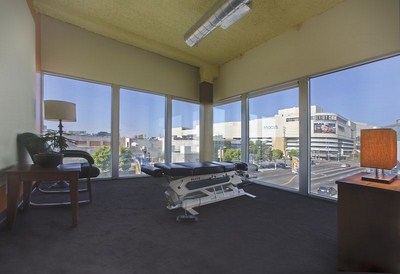
Then you have to consider what services are being performed: An adjustment in Los Angeles (Beverly Hills or Hollywood) averages around $75. Some might charge $50. If the chiropractor is also doing therapies, exercises, massage, and other services, it could be a bit more. But if it’s not much more than what another office is charging for an adjustment only, then…well, you be the judge.
So I go back to my original point: Think about the big picture. Figure out what you need (pain relief, wellness), what you are getting (services, treatments, modalities), get the total cost, then evaluate. Five minute adjustments at $50, recommended 24 visits; or thirty minute full-service treatments at $95, recommended 12 visits, you can do the math. Costs among different chiropractic offices in the same region are generally comparable but based on the work being done. That’s why it’s important to consider all factors when choosing a chiropractor and not just price alone.
Finally, if you have medical insurance, you’d better ask if the office accepts it. Some chiropractic practices (like some medical practices) accept cash only. Don’t be caught by surprise. Some consumers mistakenly believe that it’s the health care office’s responsibility to know about the insurance plan the consumer has. Please understand that insurance is billed as a courtesy. Unless an office is contracted with an insurance company, the office is not required to take it. And even in those circumstances when an office is contracted with an insurance company, it’s still the clients’ responsibility to know the details of their plan. It would be a wonderful world if everything in the medical insurance world was standardized, but it is not. There are a multitude of companies with a multitude of plans; there is just no way for an office to know everything. Be wise, know your benefits before going in. That’s the least likely way to be unpleasantly surprised later.
How Do I Find the Right Chiropractic Office for Me?
OK, so I’ve just given you an enormous amount of information; let’s put it all together so you can find the right chiropractic office for you. Remember the basics:
- What are you looking for—pain relief or wellness? Does the office I’m considering offer both? Will the chiropractor just adjust me or will they do other things like therapies and show me exercises and stretches.
- What is the practitioner’s philosophy? Are they based on the vitalistic concept of Innate Intelligence or the mechanistic body-part systems concept of the medi-practor? Are you looking for a therapist or something more? It matters.
- What are the techniques the chiropractor uses? Soft or firm, or a combination of the two? Can this particular doctor give me either form, or different techniques depending on what I need?
- Where is the office located? Is it close to home, work, or en route between the two? Will the chiropractor travel if I can’t get over there?
- What can I expect on the first visit? Will the doctor examine me? Will I be treated on the first visit? How long will it take?
- How much does it cost, and what am I getting for that price? Am I looking for a cheap “crack” or a quality adjustment? Consider all factors together.
Now a few other things to think about:
- Go with your gut. We often know, by speaking to the staff (or the doctor him or herself, don’t be shy—it’s your health), whether this is the right office for us. We hear in the conversation whether there is competency, certainty and an overall “good-feeling” with the office. Don’t deny your intuitive gut responses.
- Be wary of the “I’ll do anything” office. Price negotiating, treatment without examination, claiming to do everything—these usually scream of desperation. Do you really want to entrust your health to a professional (?) that’s desperate? I wouldn’t. How would you know you are getting what you need, and not simply what the doctor needs? Think about this a bit.
- Be wary of the “Let’s make a deal” office. As I’ve said above, if an office is willing to negotiate price, they are either desperate, not serious, or over-charging to begin with.
- Be wary of the “no exam needed” office. It’s as simple as this: if the doctor is willing to adjust you without getting your health history and looking at you, then they do not care about your health, period. This is a bold statement I know, but I stand by it. Even for the straight chiropractor unleashing the power from within, a basic spinal exam, and often x-rays, is vital. If it’s okay with you to not be examined, well, it’s your body; but me, I’d run as fast as I could. And if that’s what you want from my office—forget it, it will never happen!
So there you have it: a guide to finding the right chiropractic office to fit your needs. Everybody is different—we have different needs and different healing responses—so the one-size-fits-all model is just not realistic when it comes to finding the right chiropractor. You have to think about what you are looking for and match it to the right practitioner. Now that’s the way choosing one’s health care professional should be. If you live or work in Los Angeles, Beverly Hills or West Hollywood, or if you travel here often and need a chiropractor near Los Angles hotels, then please contact my office. I promise you that in my practice you will find warm, caring professionals and staff that will listen to you, and design a program to meet your health and wellness needs. Whether you are looking for pain relief or simply to boost your innate vitality, my Los Angeles, Beverly Hills and West Hollywood chiropractic office will put you and your health first.
-December 17, 2009

